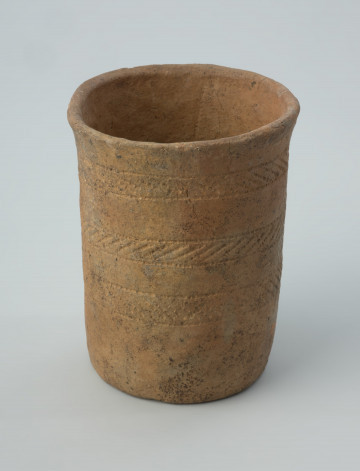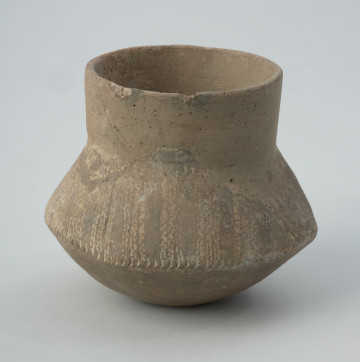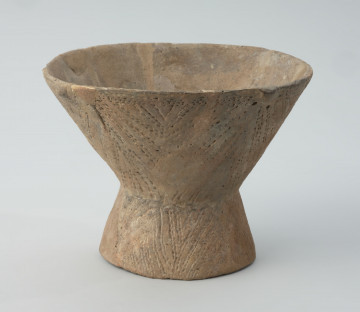
Decorated mortarboard goblet
National Museum in Szczecin
Part of the collection: Stone Age
A gently profiled earthenware goblet, decorated with cord impressions and punctures, discovered in Duchowo (now a part of Police) found its way to the collection of the Society for History and Antiquities of Pomerania (Gesellschaft für Pommersche Geschichte und Altertumskunde) in Szczecin in 1876. Schemel, the owner of the local estate donated it together with the fragments of another earthenware vessel, an axe made of diorite and two axes made of flint, a knife fragment and a skidder. All these objects came from a sand hill near the land belonging to the donor. The context of the discovery of these objects has raised doubts. They were expressed by Dr Emil Walter, a professor at St Mary's Gymnasium in Szczecin and a member of the Szczecin Society, in a publication from 1898, discussing the vessels from the Younger Stone Age in the Szczecin collection. In this study, published in a book published on the jubilee of professor Hugo Lemcke, director of the grammar school and president of the Society, he comprehensively described the find from Duchowo. He drew attention to the presence of charcoal and ruminant bones at the site, which could indicate the existence of a settlement here, although he himself tended to interpret the find as an assemblage coming from the furnishings of a grave without a chamber made of stones. This interpretation was generally accepted in later literature. However, attention was drawn to the co-occurrence in this assemblage of objects, which separately could be correlated with the early and later stages of settlement of the laconic pottery community in Western Pomerania. The shape and ornamentation of the goblet relates to the forms occurring in the oldest phase, the so-called all-European horizon of inventories of the rope pottery culture. The youngest is a flint skid, which was described as a fragment of a dagger or a javelin arrowhead, and in more recent studies it is identified with the blade of the so-called dagger scepter, modelled on copper products.
Krzysztof Kowalski
Author / creator
Dimensions
cały obiekt: height: 13.6 cm
Object type
ceramic, vessel (container)
Technique
firing, manual modelling, modelling
Material
clay
Origin / acquisition method
acquisition
Creation / finding place
Owner
National Museum in Szczecin
Identification number
Location / status

National Museum in Szczecin

National Museum in Szczecin

National Museum in Szczecin
DISCOVER this TOPIC
National Museum in Szczecin
DISCOVER this PATH
Educational path